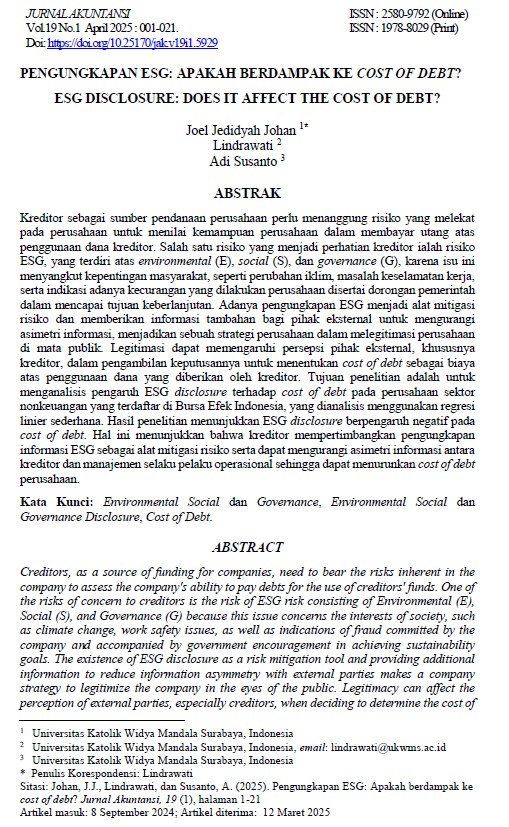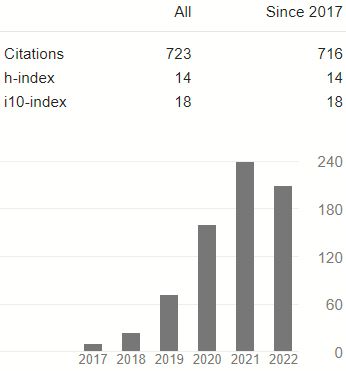ESG DISCLOSURE: DOES IT AFFECT THE COST OF DEBT?
DOI:
https://doi.org/10.25170/jak.v19i1.5929Keywords:
Environmental Social and Governance, , Environmental Social and Governance Disclosure, Cost of DebtAbstract
Creditors, as a source of funding for companies, need to bear the risks inherent in the company to assess the company's ability to pay debts for the use of creditors' funds. One of the risks of concern to creditors is the risk of ESG risk consisting of Environmental (E), Social (S), and Governance (G) because this issue concerns the interests of society, such as climate change, work safety issues, as well as indications of fraud committed by the company and accompanied by government encouragement in achieving sustainability goals. The existence of ESG disclosure as a risk mitigation tool and providing additional information to reduce information asymmetry with external parties makes a company strategy to legitimize the company in the eyes of the public. Legitimacy can affect the perception of external parties, especially creditors, when deciding to determine the cost of debt as a fee for using funds that creditors have provided. The purpose of the study is to analyze the effect of ESG disclosure by using non-financial sector companies listed on the Indonesia Stock Exchange, which were analyzed using simple linear regression analysis. The results showed that ESG disclosure has a negative effect on the cost of debt. This shows that creditors in Indonesia consider disclosure of ESG information as a risk mitigation tool and can reduce information asymmetry between creditors and management as operational actors to reduce the company's cost of debt.
References
Aboud, A., & Diab, A. (2018). The Impact of Social, Environmental and Corporate Governance Disclosures on Firm Value: Evidence from Egypt. Journal of Accounting in Emerging Economies, 8(4), 442–458. https://doi.org/10.1108/JAEE-08-2017-0079
Afazis, R. D., & Handayani, S. (2020). Penerapan Akuntansi Manajemen Lingkungan terhadap Kinerja Keuangan: Kinerja Lingkungan sebagai Pemediasi. Jurnal Bisnis dan Akuntansi, 22(2), 257–270. https://doi.org/10.34208/jba.v22i2.702
Angela, T., & Sari, N. (2023). The Effect of Environmental, Social, and Governance Disclosure on Firm Value. The 5th International Conference of Biospheric Harmony Advanced Research (ICOBAR). https://doi.org/10.1051/e3sconf/202342601078
Atif, M., & Ali, S. (2021). Environmental, Social and Governance Disclosure and Default Risk. Business Strategy and the Environment, 30(8), 3937–3959. https://doi.org/10.1002/bse.2850
Baule, R. (2019). The Cost of Debt Capital Revisited. Business Research, 12(2), 721–753. https://doi.org/10.1007/s40685-018-0070-6
Bax, K., Bonaccolto, G., & Paterlini, S. (2023). Do Lower Environmental, Social, and Governance (ESG) Rated Companies have Higher Systemic Impact? Empirical Evidence from Europe and the United States. Corporate Social Responsibility and Environmental Management, 30(3), 1406–1420. https://doi.org/10.1002/csr.2427
Bjerke, J. A. (2021). An Empirical Analysis on Ehe effect of ESG/CSR Ratings on the Costs of Capital in the Global Oil and Gas Industry [University of Stavanger, Norway]. https://uis.brage.unit.no/uis-xmlui/handle/11250/2786324
Bloomberg. (2020). Methodology for Environmental and Social Scores. https://data.bloomberglp.com/professional/sites/10/Getting-Started-Guide-for-Students-English.pdf
Dahiya, M., & Singh, S. (2020). The Linkage between CSR and Cost of Equity: an Indian Perspective. Sustainability Accounting, Management and Policy Journal, 12(3), 499–521. https://doi.org/10.1108/SAMPJ-10-2019-0379
Dash, A., & Mohanty, S. K. (2023). The Mediating Effect of a Firm’s Corporate Reputation and Sustainability Practices in Translating CSR into Competitive Performance in Indian ESG Companies. Society and Business Review, 18(4), 691–709. https://doi.org/10.1108/SBR-02-2023-0045
Dowling, J., & Pfeffer, J. (1975). Organizational Legitimacy: Social Values and Organizational Behavior. The Pacific Sociological Review, 18(1), 122–136. https://doi.org/10.2307/1388226
Dunne, T. C., & McBrayer, G. A. (2019). In the Interest of Small Business Cost of Debt: a Matter of CSR Disclosure. Journal of Small Business Strategy, 29(2), 58–71. https://jsbs.scholasticahq.com/article/26359-in-the-interest-of-small-business-cost-of-debt-a-matter-of-csr-disclosure
Eliwa, Y., Aboud, A., & Saleh, A. (2021). ESG Practices and the Cost of Debt: Evidence from EU Countries. Critical Perspectives on Accounting, 79(3), 1–21. https://doi.org/10.1016/j.cpa.2019.102097
Elkington, J. (1997). Cannibals with Forks: The Triple Bottom Line of 21st Century Business. Capstone Publishing Limited.
Fosu, S., Agyei-Boapeah, H., & Ciftci, N. (2023). Credit Information Sharing and Cost of Debt: Evidence from the Introduction of Credit Bureaus in Developing Countries. Financial Review, 58(4), 783–810. https://doi.org/10.1111/fire.12361
Ghozali, I. (2018). Aplikasi Analisis Multivariate dengan Program IBM SPSS 25 (9th ed.). Badan Penerbit Universitas Diponegoro.
Gonçalves, T. C., Dias, J., & Barros, V. (2022). Sustainability Performance and the Cost of Capital. International Journal of Financial Studies, 10(3), 1–32. https://doi.org/10.3390/ijfs10030063
Hatane, S. E., Jonathan, S. L., & Irianto, M. B. A. (2021). Pengaruh Tanggung Jawab Sosial Perusahaan terhadap Biaya Modal Ekuitas di Indonesia. Business Accounting Review, 9(1), 99–111. https://garuda.kemdikbud.go.id/documents/detail/2550500
Hidayat, M. (2023). Implementasi Konsep Triple Bottom Line dalam Pengembangan Kawasan Wisata Air Terjun Takapala Malino Gowa. Economics and Digital Business Review, 4(1), 797–804. https://doi.org/10.37531/ecotal.v4i1.425
Komite Nasional Kebijakan Governansi. (2021). Pedoman Umum Governansi Korporat Indonesia (PUGKI) 2021. https://knkg.or.id/wp-content/uploads/2022/06/PUGKI-2021-LORES.pdf
Krueger, P., Sautner, Z., & Starks, L. T. (2020). The Importance of Climate Risks for Institutional Investors. The Review of Financial Studies, 33(3), 1067–1111. https://doi.org/10.1093/rfs/hhz137
Larsson, F., & Larsson, H. (2023). Impact of ESG Performance and Carbon Emissions on Cost of Debt - a Study of the Nordic Markets. Uppsala University, Sweden.
Laurensia, Lindrawati, & Susanto, A. (2024). Sustainability Report, Institutional Ownership, and Foreign Ownership on Financial Performance with Board of Commissioners as Moderating. Jurnal Ilmiah Manajemen Dan Bisnis, 9(1), 108–123. https://doi.org/10.38043/jimb.v9i1.5987
Maaloul, A., Zéghal, D., Amar, W. Ben, & Mansour, S. (2023). The Effect of Environmental, Social, and Governance (ESG) Performance and Disclosure on Cost of Debt: the Mediating Effect of Corporate Reputation. Corporate Reputation Review, 26(1), 1–18. https://doi.org/10.1057/s41299-021-00130-8
Maurer, J. G. (1971). Readings in Organization Theory: Open-System Approaches. Random House.
Myers, S. C., & Majluf, N. S. (1984). Corporate Financing and Investment Decisions when Firms have Information that Investors Do Not Have. Journal of Financial Economics, 13(2), 187–221. https://doi.org/10.1016/0304-405X(84)90023-0
Oktaviani, D. D., & Nurleli. (2023). Pengaruh Pengungkapan Sustainability Reporting terhadap Kinerja Keuangan. Bandung Conference Series: Accountancy, 3(1), 337–344. https://doi.org/10.29313/bcsa.v3i1.6367
Otoritas Jasa Keuangan. (2017). Peraturan Otoritas Jasa Keuangan Nomor 51 /POJK.03/2017 tentang Penerapan Keuangan Berkelanjutan bagi Lembaga Jasa Keuangan, Emitten dan Perusahaan Publik. https://ojk.go.id/id/regulasi/Pages/Penerapan-Keuangan-Berkelanjutan-bagi-Lembaga-Jasa-Keuangan,-Emiten,-dan-Perusahaan-Publik.aspx
Parsons, T. (1960). Structure and Process in Modern Societies. United States of America.
Pham, D. C., Do, T. N. A., Doan, T. N., Nguyen, T. X. H., & Pham, T. K. Y. (2021). The Impact of Sustainability Practices on Financial Performance: Empirical Evidence from Sweden. Cogent Business and Management, 8(1), 1–19. https://doi.org/10.1080/23311975.2021.1912526
Piechocka-Kaluzna, A., Tluczak, A., & Lopatka, P. (2021). The Impact of CSR/ESG Reporting on the Cost of Capital: an Example of US Healthcare Entities. European Research Studies Journal, XXIV(2), 679–690. https://doi.org/10.35808/ersj/2502
Pirgaip, B., & Rizvić, L. (2023). The Impact of Integrated Reporting on the Cost of Capital: Evidence from an Emerging Market. Journal of Risk and Financial Management, 16(7), 311. https://doi.org/10.3390/jrfm16070311
Pollman, E. (2022). The Making and Meaning of ESG (U of Penn, Inst for Law & Econ Research Paper No. 22-23, European Corporate Governance Institute-Law Working Paper No. 659/2022, Harvard Business Law Review, Vol. 14, p. 403). https://papers.ssrn.com/sol3/papers.cfm?abstract_id=4219857
Sharfman, M. P., & Fernando, C. S. (2008). Environmental Risk Management and the Cost of Capital. Strategic Management Journal, 29(6), 569–592. https://doi.org/10.1002/smj.678
Suchman, M. C. (1995). Managing Legitimacy: Strategic and Institutional Approaches. The Academy of Management Review, 20(3), 571–610. https://doi.org/10.2307/258788
Tanjung, M. (2023). Cost of Capital and Firm Performance of ESG Companies: What can We Infer from Covid-19 Pandemic? Sustainability Accounting, Management and Policy Journal, 14(6), 1242–1267. https://doi.org/10.1108/SAMPJ-07-2022-0396
Valta, P. (2016). Strategic Default, Debt Structure, and Stock Returns. The Journal of Financial and Quantitative Analysis, 51(1), 197–229. https://doi.org/10.1017/S002210901600003X
Vivianita, A., P, F. N., & Indudewi, D. (2021). Pengaruh Environmental Performance terhadap Firm Value dengan Female Commissioner sebagai Variabel Moderasi (Studi Kasus pada Perusahaan Manufaktur di BEI 2016-2018). Indonesian Journal of Accounting and Business, 2(2), 99–106. https://doi.org/10.33019/ijab.v2i2.30
Wu, W. (2023). Corporate ESG Performance and Cost of Debt Capital. Highlights in Business Economics and Management, 9, 7–19. https://doi.org/10.54097/hbem.v9i.7764

Downloads
Published
Issue
Section
License
Copyright (c) 2025 Joel Jedidyah Johan, Lindrawati Lindrawati, Adi Susanto

This work is licensed under a Creative Commons Attribution-ShareAlike 4.0 International License.
Authors who publish with this journal agree to the following terms:
- Authors retain copyright and grant the journal right of first publication with the work simultaneously licensed under a Creative Commons Attribution-ShareAlike 4.0 International License that allows others to share the work with an acknowledgment of the work's authorship and initial publication in this journal.
- Authors are able to enter into separate, additional contractual arrangements for the non-exclusive distribution of the journal's published version of the work (e.g., post it to an institutional repository or publish it in a book), with an acknowledgment of its initial publication in this journal.
- Authors are permitted and encouraged to post their work online (e.g., in institutional repositories or on their website) prior to and during the submission process, as it can lead to productive exchanges, as well as earlier and greater citation of published work.














